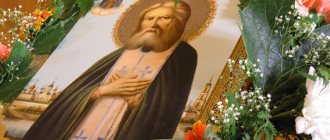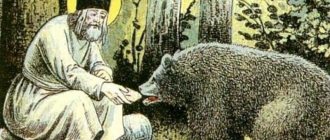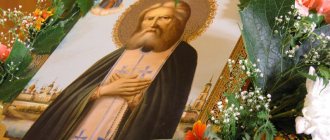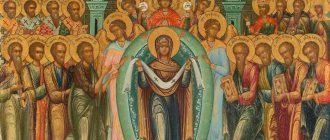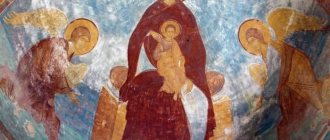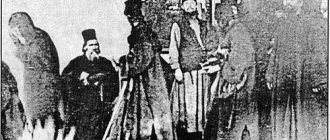Athos The Second Destiny of the Blessed Virgin Mary
In 48, the Mother of God, together with John the Theologian, was forced to flee the persecution that Herod inflicted against Christians. They decided to seek salvation in Cyprus - at that time Lazarus, who had once been resurrected by Christ, was the bishop there. But on the way they encountered a strong storm and were forced to land at Mount Athos. The beauty of these places struck the Mother of God so much that she began to beg her Son to grant Her the entire Mount Athos. And then a voice sounded from Heaven: “Path this place will become Your destiny, and a garden, and a paradise, and also a refuge for those who thirst for salvation.” After this, the Mother of God preached to the local residents, and they, although they had previously professed paganism, were baptized.
The Mother of God announced:
“This place will be for me from my Son and my God. May the grace of God be in this place and on those living here, who faithfully fulfill the commandments of My Son. They will have everything necessary for earthly life, and the mercy of My Son and God will not fail for them until the end of the century. I will be the Intercessor of this place and will ask for it before God.” The Mother of God began miraculously sending ascetics to Athos. The first of them was the Monk Peter. The Most Pure Virgin revealed to him that there was and is no better place to serve God, and that “the time will come when it will be filled from end to end, north and south, with many monks.”
Martyrs of the Georgian land
The fact that Christian communities existed in Ancient Iberia in the 1st–3rd centuries after the Nativity of Christ is evidenced by archaeological and toponymic data. Already in the 2nd century AD. In the chronicles, among the Christian peoples, the Ivers - Georgians - are mentioned. Although at this time Christians here were persecuted: at the beginning of the 2nd century, Saint Sukhoi and 16 of his warrior-companions from noble Georgian families suffered martyrdom. Their memory is celebrated on April 28. All of them at one time were nobles, but having learned about Christ and having accepted Baptism, they left a life full of pleasures at court and, secluded to pray in the mountains, became ascetics. But the pagan king did not tolerate such disgrace for his way of life, and all the ascetics were brutally killed.
In general, martyrdom runs like a red thread throughout Georgian history. Moreover, for the Ibelians, the confession of Christ from time immemorial was identified with the struggle for the identity of the people, and later for their statehood.
When in 1226 Khorezm Shah Jalal-ed-din captured the capital of Georgia, Tbilisi, he ordered the dome of the Zion Cathedral of the Assumption of the Mother of God to be removed and placed his throne there. Icons of the Savior and the Blessed Virgin Mary were placed on the bridge. Tbilisi residents were ordered to walk along them, desecrating the images with spitting. Those who refused were immediately beheaded and thrown into the river. On that day, 100,000 Christians in Tbilisi forever adorned themselves with martyr's crowns. They are commemorated on November 13th.
In 1386, Tamerlane, having captured the Kvabtakhevsky monastery, wanting to abuse and humiliate the brides of Christ, forced them to sing and dance. For her refusal, the martyr, along with other residents of Georgia devastated by the conqueror, were burned alive in the cathedral church of the Most Holy Theotokos. The memory of the Kvabtakhev martyrs is celebrated on April 23.
In 1616, during the invasion of Shah Abbas, 6,000 monks of the David Gareji Monastery, who had just celebrated the Resurrection of Christ, asked the executioners to complete the Easter service. Their memory, like that of the Kvabtakhev martyrs, is celebrated on April 23. Two of them hid at first, but seeing with what grace the Lord covered the martyrdom, they themselves jumped out of their hiding places to meet the triumph of martyrdom for Christ. Didn’t they say to each other and to the executioners before departing to the Lord: Christ is Risen!
It is believed that the Russian people, who did not know strong persecution throughout their Christian history, were allowed to enter the 20th century. That is why, although there were repressions in Georgia during the Soviet years, they were not so severe. His Holiness and Beatitude Catholicos-Patriarch of All Georgia Ilia II, who has headed the Georgian Orthodox Church since 1977, even once called the Tbilisi Church of the Holy Blessed Prince Alexander Nevsky “a branch of the Glinsk Hermitage” - it was here that they labored after the repeated closure of this illustrious monastery during the atheistic years her elders.
In Tbilisi, many of them are laid to rest - these are those who are now glorified as saints: Metropolitan Zinovy (Mazhuga), in the schema Seraphim, Schema-Archimandrite Andronik (Lukash), Schema-Archimandrite Seraphim (Romantsov), as well as the one whose glorification is awaited by the entire Orthodox people - Schema-Archimandrite Vitaly (Sidorenko). We warmly love the Russian, as well as the Georgian, people and the Georgian holy fool archimandrite of our times - the Monk Gabriel (Urgebadze).
Pilgrimage to the places of exploits and to the graves of these most beloved Orthodox saints of our days is a special blessing for those who themselves would like to inherit at least a part of their ascetic spirit, just as they inherited it from their predecessors. This country, blessed with the promises of God and the patronage of the Most Holy Virgin Mary Herself, could not, in its reciprocal love for God, show lesser fruits of heroism and self-denial: throughout the centuries and right up to the present day.
The third destiny of the Mother of God Kyiv
Indeed, over time, many monasteries appeared on Mount Athos. And so, in the second half of the 11th century, in the monastery of Esphigmen, monk Anthony, who came here from Kievan Rus, took monastic vows.
Anthony left, but soon returned. Several years passed, and when Yaroslav the Wise became the Grand Duke of Kyiv, the abbot again had a Divine revelation about the need to send Anthony away. Having reached Kyiv, he settled in a cave on the banks of the Dnieper, where he spent all his time in fasting and prayer. Soon people began to turn to him for advice and blessings. Some wished to stay with him and take monastic vows.
This is how the Kiev Pechersk Lavra was formed - the third inheritance of the Mother of God.
Iveria
In 44 AD, St. the apostles and the Virgin Mary decided who would go where and preach the word of God. As a result, Iberia fell to the Most Pure Virgin. The lands became the First Lot of the Mother of God, and the path of Mary herself lay in the other direction to Mount Athos.
Historical region of Georgia - Iveria
The first-called Andrew went to Iveria. The Apostle preached the Gospel. The Orthodox faith found a response in the souls of the Greeks.
Diveevo is the fourth destiny of the Most Holy Theotokos on Earth
The beginning of the fourth destiny resembles the formation of the third. One Nizhny Novgorod noblewoman named Agafya Semenovna Belokopytova married a wealthy landowner Melgunov. Having been widowed, Agafya decided to go to a monastery, choosing the Frolovsky monastery and taking monastic vows there with the name of Alexander.
Once, after the all-night vigil, the nun saw “in a subtle vision” the Most Holy Theotokos, who said to her: “Get out of here and go to the land that I will show you. Go to the north of Russia and there will be a place where I will show you to end your godly life.”
Having traveled a long way, in 1760 Alexandra reached the village of Diveevo. Tired, she fell asleep sitting and in a light drowsiness she was again honored to see the Mother of God, who pointed out: “Here is the limit that Divine Providence has set for you: live and please the Lord God here until the end of your days.”
This is how the Seraphim-Diveevo Monastery arose - the fourth inheritance of the Most Holy Theotokos on Earth.
Seraphim-Diveevo Monastery
In Russia there is the only Destiny of the Most Holy Theotokos. In the 8th century nun Alexandra, at the request of the Mother of God, founded a monastery near Sarov. Alexandra became a monk, leaving behind a rich life. The landowner Agafya Melgunova is a thing of the past.
Appearance of the Most Pure Virgin Agafya
In Diveevo, every pilgrim walks along the Holy Kanavka. Mary herself was walking along the bridge when she appeared to Venerable Seraphim.
holy groove
Believers walk slowly, some barefoot as a sign of veneration, and read the prayer “Hail to the Virgin Mary!” to themselves 150 times.
Nature
Holy Mount Athos is a unique place. Geographically, Athos is located on the Chalkidiki peninsula in Greece. It is a peninsula jutting into the Aegean Sea and ending in the south with a 2033-meter-high mountain. It is also called Athos. The Mediterranean climate provides the Athonites with warm, rainy winters, winds in the cold season, and sultry sunny summers. Water from mountain streams is used for drinking.
Vineyards of Athos
There is very little vegetation on the southern, rocky part of the mountain. In other places, Athos abounds in vegetation: there are oak groves, spruce trees, chestnuts, plane trees, and shrubs. In high places there are moorlands. Svyatogorsk residents are engaged in growing olives, citrus fruits, walnuts, fruits and grapes.
Types of settlements
It is prohibited to establish new monasteries on the Holy Mountain.
In addition to monasteries, there are other types of settlements on Mount Athos:
- hermitages (there are 12 hermitages in total) - settlements similar to monasteries, but without such status;
- kaliva - settlements that make up the hermitages;
- cells are fairly large settlements with vast tracts of land;
- kathismas - single villages;
- hesychastiria - abodes of hermits.
All monasteries are under the jurisdiction of the Patriarch of Constantinople, which is why they are also called stauropegial.
Monasteries differ from other settlements in that they have the right to participate in government and own land property, unlike the latter. All monasteries on Mount Athos are cenobial, or cenobitic. Several monasteries remain special.
Of the 20 monasteries of Athos, 17 are Greek, one Russian - Rossikon (St. Panteleimon), one Bulgarian - Zograf, and Serbian - Hilandar. In addition, the theological school “Athoniada” has been operating in Kareya since 1749.
Monastic state
Athos received the status of an autonomous republic in 972 during the rule of Byzantium. The capital of the monastic republic is Karye. Supreme power belongs to Holy Kinot, consisting of representatives of 20 Athonite monasteries. Secular power is also represented on Mount Athos: the governor, police officers, postal employees, merchants and artisans, medical personnel and bank employees.
The governor, appointed by the Greek Minister of Foreign Affairs, is responsible for security and order on Mount Athos. Athos is a private property, the territory of the Mountain is divided into 20 parts between the monasteries located here.
The Charter of Athos enshrines a well-known custom - a ban on visiting the Mountain for women and female animals. The monks made an exception for chickens that lay eggs and cats that catch rodents. For entering the territory of Mount Athos, women are subject to criminal liability - 8-12 months of imprisonment.
According to the covenant of the Mother of God, no woman except Her can set foot on the land of Athos. According to legend, in 422, the daughter of Theodosius the Great, Placidia, visited the Holy Mountain, but was prevented from entering the monastery by the gentle and reproachful voice of the Mother of God.
The rules for visiting the Holy Mountain for men are also strict. Here it is forbidden to wear bright clothes and swim, sunbathe, use foul language, smoke and talk loudly. Video and photography are also prohibited. Men receive special permission to visit. Sectarians and pagans are prohibited from entering the Holy Mountain.
It is necessary to plan a visit to Mount Athos and send a request for permission six months before your visit to Greece. Permission to visit the Holy Mountain arrives several weeks before the specified date by email and telephone number of the tourist. Pilgrims can take with them their male children or grandchildren who have reached school age. On September 9, 2007, Russian President Vladimir Putin visited Athos. On May 28, 2016, during his second visit, Patriarch Kirill of Moscow and All Rus' visited Mount Athos with him.
No one is responsible for the safety of pilgrims. Poisonous snakes and scorpions live here. The road to the hermit monks is dangerous: along a steep cliff there is a narrow path at an altitude of 100 meters. Holding onto chains nailed to the rock, not everyone decides to make their way to the hermits.
On Athos, the Julian calendar is used, including in administrative documents. A new day here begins at sunset. Time on Mount Athos differs from Greek time by 3 hours in summer, and by 7 hours in winter. Before sunrise, when people in the world wake up, 300 Liturgies are served on Mount Athos.
Control
Athos is part of Greece, and is officially called the Autonomous Monastic State of the Holy Mountain. The capital of Athos is the village of Kareya, or Karyas. The Holy Mountain has its own Constitution - the Statutory Charter of the Holy Mount Athos, published in 1924, and which entered into legal force in 1926. Article 105 of the Greek Constitution confirms the special status of Athos.
Kareya (Karyas)
The monastic state is formed by 20 monasteries, divided into 5 groups:
- Great Lavra, Dochiar, Xenophon, Esphigmen.
- Vatopedi, Kutlumush, Karakal, Stavronikita.
- Iversky, Pantocrator, Philotheus, Simonopetra.
- Hilandar, Xiropotamus, St. Paul, Grigoriat.
- Dionysiatus, Zograf, St. Panteleimon, Konstamonite.
Each group nominates representatives once a year to the executive branch of the Holy Mountain - the Sacred Epistasia. In addition, each of the 20 monasteries annually elects representatives to the supreme body of self-government - the Holy Kinot.
In Karea there is a representative of Greece - a governor, subordinate to the Minister of Foreign Affairs, with a small staff of employees - clerks and police. The main task of the governor is to monitor compliance with civil law.
